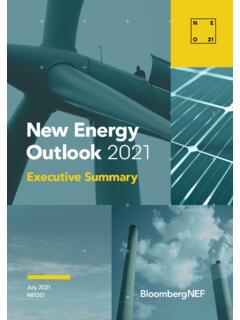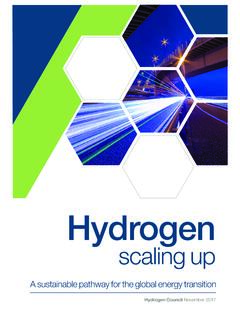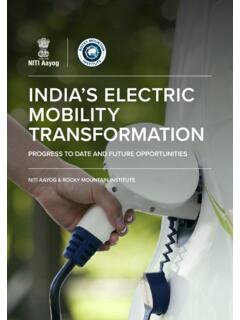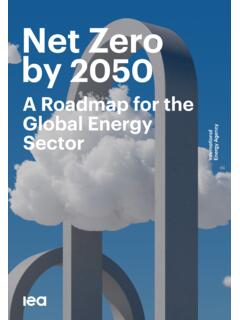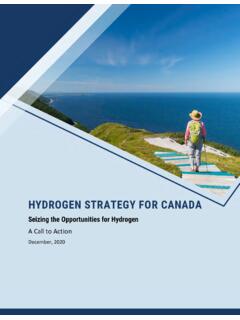Transcription of B.C. Hydrogen Strategy
1 Hydrogen StrategyA sustainable pathway for s energy transition For British Columbia to meet its CleanBC goals, we must shift how we produce and consume energy. Renewable and low-carbon Hydrogen will play a critical role in our sustainable energy future. With our clean hydroelectricity, abundant natural resources and innovative companies, can be a world leader in the growing Hydrogen economy creating new cleantech jobs and opportunities for people across the province. The Hydrogen Strategy lays out the actions we will take together to realize this vision on the path to net-zero emissions by 2050. Honourable Bruce Ralston Minister of Energy, Mines and Low Carbon Innovation Hydrogen energy is essential to achieving carbon neutrality by 2050 and limiting global warming to less than two degrees Celsius.
2 Canada is fortunate in that we not only have a leading fuel cell sector centred in , but also leading Hydrogen technology and production companies. This represents a huge opportunity for to produce the significant quantities of Hydrogen that will be needed at home and abroad from our abundant, low-cost renewable power and also, when coupled with CO2 sequestration, from our natural gas resource. Hydrogen will enable industries from ports to trucking and mining to urban transportation to thrive in a carbon-constrained world. Mark Kirby, President & CEOC anadian Hydrogen and Fuel Cell Association Renewable electricity can help reduce emissions in road transport, low-temperature industrial processes and in heating buildings.
3 However, fossil fuels have a significant advantage in applications that require high energy density, industrial processes that rely on carbon as a reactant, or where demand is seasonal. To fully decarbonize the world economy, it s likely a clean molecule will be needed and Hydrogen is well placed to play this role. It is versatile, reactive, storable, transportable, clean burning and can be produced with low or zero emissions. BloombergNEF, Hydrogen Economy Outlook A huge step in the fight against climate change has been taken, as both governments and investors now fully grasp the role Hydrogen can play in the energy transition.
4 Now, to bring this potential to its full fruition, governments, investors and industrial companies must work together to scale up the Hydrogen ecosystem around the world. Their collaboration in the coming months will allow for many of the projects around the world to become a reality and to turn Hydrogen into a new, clean , abundant and competitive energy carrier, - Beno t Potier, Chairman and CEO of Air Liquide and Co-Chair of the Hydrogen Council Hydrogen can help overcome many difficult energy challenges. It can decarbonize hard-to-abate-sectors like steel, chemicals, trucks, ships and planes. Hydrogen can also enhance energy security by diversifying the fuel mix and providing flexibility to balance grids.
5 - Fatih Birol, Executive Director of the International Energy Agency There is significant momentum building globally for the development and deployment of fuel cells and Hydrogen at commercial scale. Numerous countries in Asia, the Americas, Europe and Africa have national Hydrogen strategies or initiatives in place, some with medium- and long-term deployment targets all with a view to addressing societal issues including energy security and resiliency, economic growth and innovation, and environmental goals. Tim Karlsson, Executive Director of the International Partnership for Hydrogen and Fuel Cells in the EconomyPowering our transition to a lower-carbon future4H2 ContentsEXECUTIVE SUMMARY 5 OBJECTIVES 7 ENERGY AND HOW IT S USED IN S LEADERSHIP IN THE Hydrogen ECONOMY 9 PRODUCING Hydrogen IN 11 GHG emissions intensity of different Hydrogen production methods 12 Hydrogen storage and distribution 13 Low-carbon Hydrogen
6 Production pathways 14 Cost of Hydrogen production 15 How we ll grow Hydrogen production 16 Codes and standards 17 How we ll regulate Hydrogen production 18 USING Hydrogen IN 19 Blending Hydrogen with natural gas to decarbonize heating and power 19 How we ll support blending Hydrogen with natural gas 20 Fuelling our transportation sector 21 Building out Hydrogen fuelling infrastructure 23 How we ll encourage the growth of Hydrogen in transportation 24 Producing low-carbon and synthetic fuels 25 Decarbonizing industrial processes 26 How we ll support industry to increase Hydrogen use 26 FUELLING ECONOMIC DEVELOPMENT 28 Hydrogen s key contribution to s net-zero economy 28 Hydrogen in Indigenous and remote communities 29 How we ll advance Hydrogen as a source of clean energy in communities 30 Exporting Hydrogen 31 How we ll develop s export market for Hydrogen 32 MEASURING OUR SUCCESS 33 SUMMARY OF POLICY ACTIONS 345H2 British Columbia is committed to achieve net-zero emissions by 2050.
7 It is an ambitious target given that two-thirds of the energy we use for transportation, buildings and industry currently comes from fossil fuels. Meeting our CleanBC goals requires a determined effort to increase energy efficiency, electrify the economy and switch to low-carbon fuels such as biofuels and Hydrogen . When burned or used in a fuel cell, Hydrogen produces no carbon emissions. Large-scale deployment of renewable and low-carbon Hydrogen will play an essential role in reducing s emissions. Independent estimates suggest that Hydrogen has the potential to reduce annual emissions by megatonnes by 2050 equivalent to 11% of the province s 2018 of its versatility, Hydrogen is one of the only solutions for decarbonizing sectors of the economy where direct electrification is not practical, such as heavy-duty transportation and industrial heat.
8 Hydrogen can be used in fuel cells to produce energy for transportation and stationary power systems, especially important for industrial sites and remote communities powered by diesel. When blended into the natural gas grid, Hydrogen can displace fossil fuels to heat and power our homes and buildings. Hydrogen can also be used for producing low-carbon synthetic fuels to reduce emissions in transportation and the potential of Hydrogen requires government, industry and researchers to work together. As part of CleanBC, the Hydrogen Strategy outlines the Province s plan to accelerate the production and use of renewable and low-carbon Hydrogen and be a world leader in the growing Hydrogen economy.
9 Executive summaryThe Strategy includes 63 actions to undertake over the short term (2020-2025), medium term (2025-2030) and long term (2030-beyond). These include: incentivizing the production of renewable and low-carbon Hydrogen ; developing regional Hydrogen hubs where production and demand are co-located; financial supports for deploying fuel cell electric vehicles and infrastructure; expanding the use of Hydrogen across different industrial sectors and applications; promoting the adoption of Hydrogen in areas where it is most cost-effective in terms of emission reductions; creating the Centre for Innovation and clean Energy to drive the commercialization of new Hydrogen technology.
10 And establishing ambitious carbon-intensity targets and a regulatory framework for carbon capture and has already implemented robust policies to encourage Hydrogen use in the transportation sector. s carbon tax and low carbon fuel standard (LCFS) are reducing emissions while incentivizing the switch to renewable and low-carbon fuels. CleanBC committed to increasing the stringency of the LCFS by doubling the required reduction in carbon intensity of transportation fuels to 20% by 2030. Introduced in 2019, the Zero-Emission Vehicles Act requires automakers to meet an escalating annual percentage of new light-duty zero-emission vehicle sales, including Hydrogen fuel cell electric vehicles.










